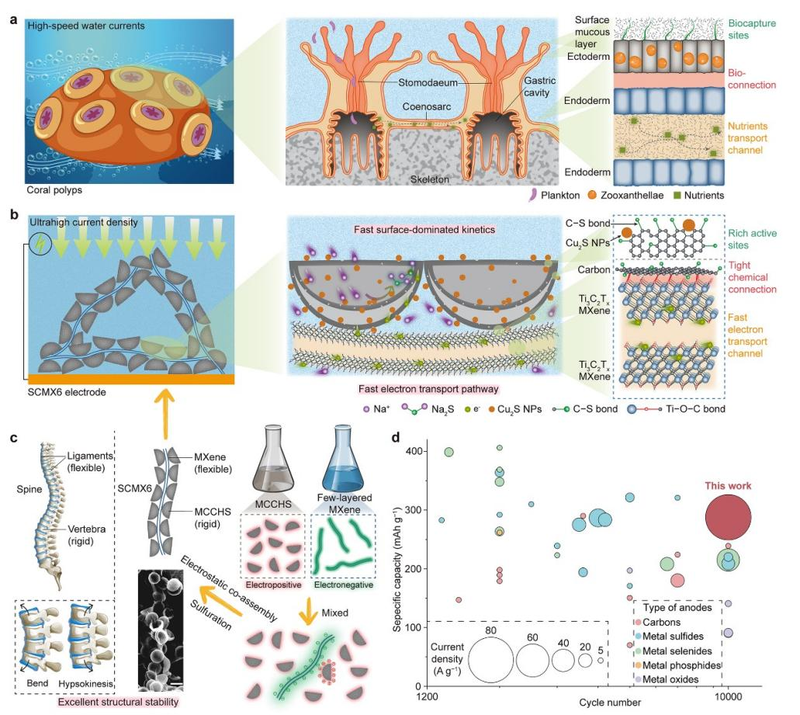The rapid development of the Internet of Things (IoT), wearable devices, flexible electronics and intelligent cities — that interconnect the sensors, actuators, communication devices, data analytics engines, and the like — has stimulated the growing need for high-power energy storage batteries. However, how to construct a micro/nano architecture to achieve anodes with rich active sites and stable structure remains a significant challenge due to relatively weak long-term cycling stability and capacity performance of alkali metal ion batteries at ultra-high rates.
Herein, drawing inspiration from elaborated structures in nature, the research teams propose a dual-biomimetic (both coral polyp-like and spine-like) gradient hierarchical architecture of electrodes. Coral polyps prefer to live in oceanic environments with fast water currents, where they can efficiently capture abundant plankton, and acquired nutrients can be efficiently transported by their laminar cavity of coenosarc. The biological behavior of coral polyps in fast water currents is similar to ion adsorption, conversion, and transportation of sodium-ion batteries (SIBs) at high rates. Besides, mammalian spine — which comprises continuous flexible ligaments and separated rigid vertebras to enable trunk support and flexibility under various body motion states — may offer some inspiration in designing spatial architecture with enhancing mechanical characteristics. Based on the above hypotheses, the research teams integrate mesoporous carbon concave hollow spheres (MCCHS) with few-layered 2D-conductive-network MXene, after sulfuration termed as SCMX through electrostatic induction and chemical welding.
As a proof of concept, the sodium storage performance of the SCMX architecture at ultrahigh rates is evaluated. The results are that it maintains a high reversible capacity of 287.7 mAh g−1 at 80 A g−1 after 10 000 cycles, and that for full-cell type sodium-ion hybrid capacitors (SICs), the SICs can still maintain an energy density of up to 50.68 Wh kg-1 when subjected to a high power density of 35, 878 W kg-1. All this shows that the SCMX architecture may hold promise in high power applications in the future, such as wearable IoT devices, and public transportation.
The work, entitled “Coral Polyp and Spine Dual-Inspired Gradient Hierarchical Architecture for Ultrahigh-Rate and Long-Life Sodium Storage,” was published in the journal Advanced Functional Materials. FNU is the first institution of the paper, with Wang Zhen, a doctoral student of FNU, and Professor Liu Yang, as the co-first authors, and Professor Liu Yang, Professor Zhao Yi and Academician Huang Wei as the co-corresponding authors. The work was supported by the National Natural Science Foundation of China, the Natural Science Foundation of Fujian Province, and so on.
Paper link: https://onlinelibrary.wiley.com/doi/full/10.1002/adfm.202402178

(Translated by Chen Junfan/ Reviewed by Xie Xiujuan)
